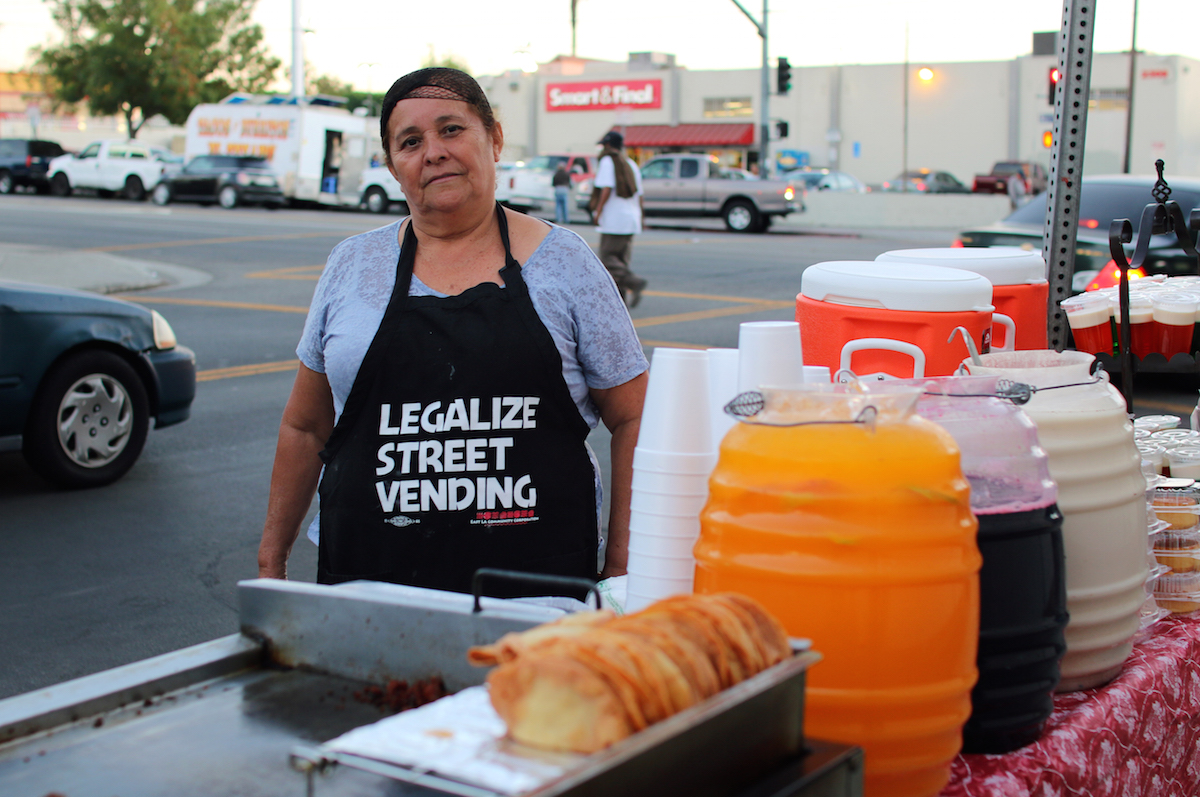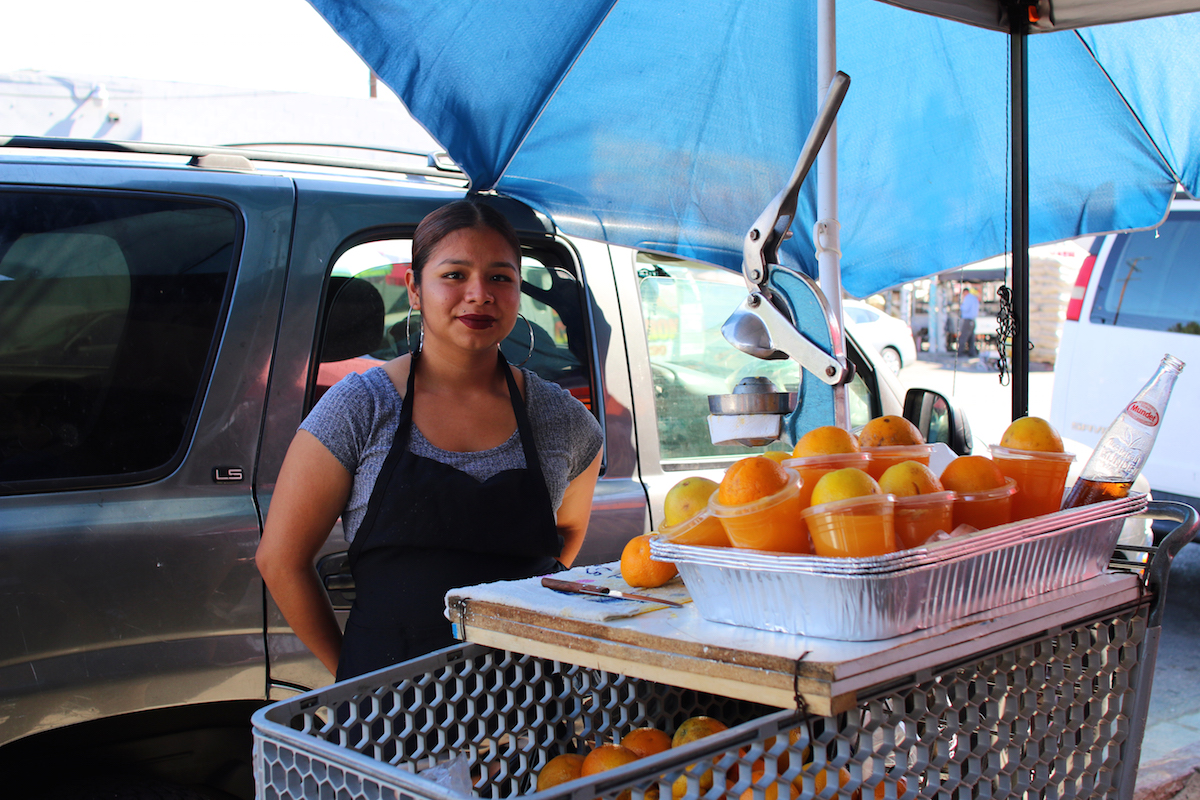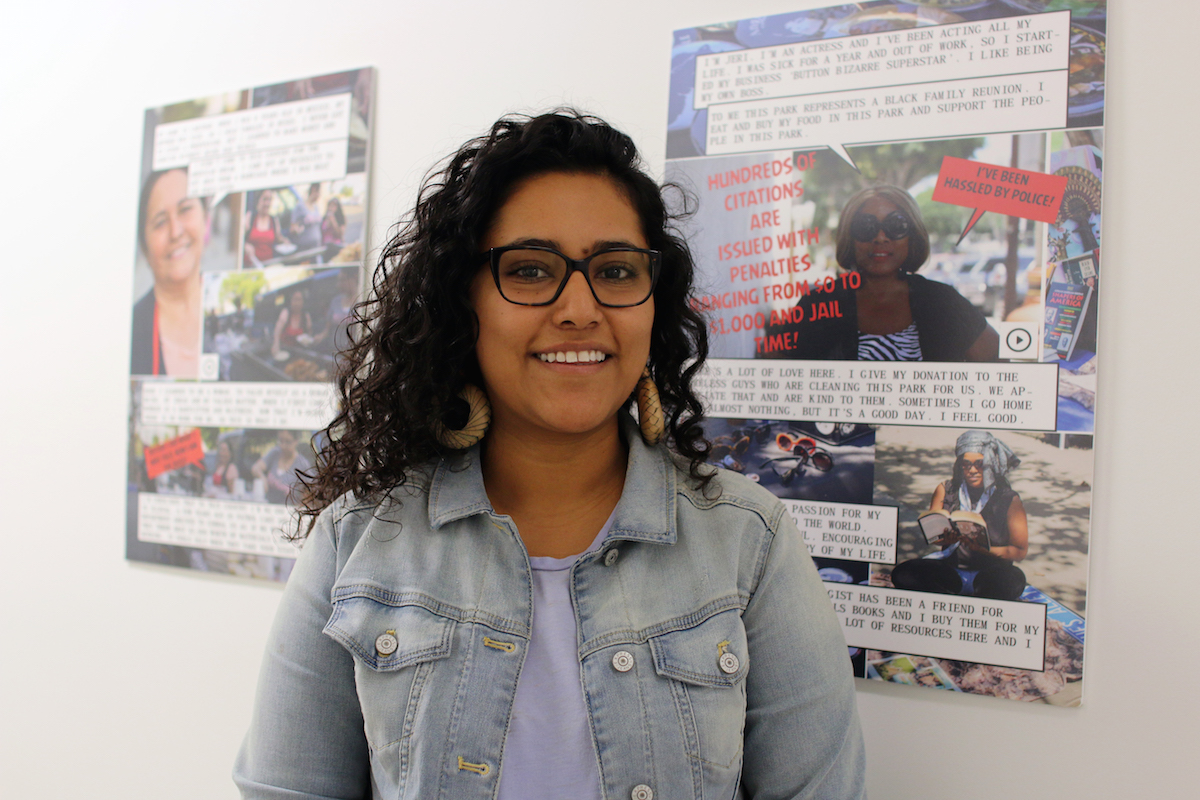“I’ve had my stand confiscated five times. Twice here and three times on Cesar Chavez,” says Caridad Vasquez, a street vendor in her 60s originally from Colima, Mexico. She’s sold her pozole, quesadillas, and tacos for nine years on a Boyle Heights street corner.
“When the county comes and takes away your things, you have no idea the suffering and the impotency you feel of not being able to scream because they are taking away your livelihood,” Vasquez describes.
People from the neighborhood arrive and she greets them energetically: “Hola mijo! Vas a comer? Ya comiste? Vente!” Her personality and Mexican antojitos are a staple, making her cart a gathering place for the community who seeks a little piece of home.
“They come here and they say ‘Oh Doña Cari, every time I come here to eat one of your quesadillas, I remember my country, I remember my mother.’ And as a vendor that’s a great satisfaction that you to give your countrymen,” Vasquez adds.

While street vendors have recently attracted headlines due to the horrible abuse they face, especially after an angry passerby flipped over elotero Benjamín Ramírez’s cart, it’s important to note that their plight is nothing new. As a result, vendors and organizers have worked tirelessly for years to legalize these businesses in Los Angeles.
Caridad Vasquez is not only an important member to her community through the nostalgia and food she provides – she’s also the pioneering vending leader of the Legalize Street Vending Campaign.
She used to sell on Cesar Chavez Boulevard along with 30 other vendors who trickled in after the recession. “It would get so nice at night, like a Mexican thing, with joy and even mariachis,” she recalls. But the police got word soon enough and displaced the vendors. When she was fed up with the constant harassment and fear of losing her livelihood, she decided to contact East LA Community Corporation (ELACC), a non-profit that advocates for low-income communities on the eastside of Los Angeles. The organization heard her concerns and decided to start a legalization campaign spearheaded in large part by Janet Favela, a former organizer with ELACC. In 2009, Caridad was alone; today there are around 2,000 vendors who are part of the movement along with more than 63 organizations that form a coalition.
“It’s been mostly women who have led this movement and this fight,” explains Merced Sánchez, a vendor and another leader in the campaign. “When will council realize that we are small business owners? We are entrepreneurs who generate money and jobs.”
“When will council realize that we are small business owners?”
ELACC, along with the vendors, created zones throughout the city with vending leaders who organize their co-workers. They hold meetings with these leaders once a month and provide them with leadership and organizing seminars. It was the vendor leaders who helped draft the proposal for legalization with the lawyers and who lobby council members to support their movement.
“I now have the courage to tell my comrades, ‘Don’t feel humiliated, defend your rights, fight, scream!’” says Vasquez in an authoritative tone and fire in her eyes.
The campaign advocated for full legalization for the first eight years, but when Trump got elected and threatened to deport anyone with a criminal record (even a misdemeanor), there was an urgency to decriminalize street vending immediately in order to protect these merchants who are often undocumented.

While the city decriminalized street vending in February, it has yet to implement a permitting system, meaning vending is still illegal. While street vendors can’t be charged with a crime, they can still have their things confiscated by the health department and cops can still ticket them for selling on sidewalks.
Eight months have passed since vendor leaders like Caridad Vazquez worked with attorneys to draft and present a permitting system proposal. Council still hasn’t presented their report with the details of a permitting system.
This is particularly troubling because many vendors are amassing huge ticket debts in the meantime, which could prohibit them from being able to afford permits once the legalization system kicks into full gear. Furthermore, many vendors will have to purchase new carts and rent commercial kitchens in order to meet health code regulations. Tamaleros, for example, won’t be able to sell out of coolers or make tamales at home. This is an added cost vendors will have to factor into their business budgets.
“Being able to vend calmly without the fear of harassment is worth it,” explains Sánchez.
The piñata district of Los Angeles is a bustling corridor of brightly colored warehouses selling party supplies and, of course, piñatas. On weekends, the area is full of multicolored umbrellas under which vendors sell regional Mexican and Central American foods as well as merchandise. It’s here, where Sanchez has sold T-shirts, baseball caps, and baby clothes for seven years after her stand in the Fashion District burnt down. Upon seeing how often police officers threw away or even give away their merchandise, she decided to join Caridad in the movement.
Because a majority of the city’s street vendors are immigrants and often undocumented, a huge concern for the campaign is that street vending is still a criminal offense in parks. This means the elotero in Echo Park or the paleta vendor in MacArthur Park could be charged with a misdemeanor and be at risk for deportation.
“We are working on decriminalizing parks, which would go to the parks committee first. The chair of the parks committee is Mitch O’Farrell. His office has been a little reluctant to move on this quickly,” says Carla DePaz, the organizing director at ELACC since 2013.

While the final details of the legalizing plan are still in the works, there are a few ideas circulating that concern the campaign such as implementing a four-vendor per-block cap.
“There are some blocks that are huge. There are some blocks that have high density that have built entire micro-economies around vending and taking that away could really hurt people’s lives. So we don’t want an arbitrary number we want a health and safety reason for caps,” says DePaz.
Much of the opposition regarding street vending revolves around merchants not paying taxes, meeting health codes, and the fear that they take away business from nearby brick and mortars. Yet, a regulated permitting system would alleviate the majority of these fears requiring vendors to meet health codes and pay taxes.
As to the competition element, studies show that street vending can increase foot traffic and lead to more revenue for all.
“It’s this concept of having active streets. If you have more foot traffic it can benefit anyone. It’s like a mall. if you’re at a mall you have multiple jewelry stores, you’ll have multiple juice shops, sometimes you have Coffee Bean here and Starbucks over there and they both do well because you have so much foot traffic,” explains DePaz. “It’s more of this question of who is allowed to be on the sidewalk and what does it look like in this community for a poor brown woman to be set up outside of a luxury boutique.”
“It’s more of this question of who is allowed to be on the sidewalk.”
Another benefit to creating active streets with vending is the possibility of safer neighborhoods due to increased lighting, foot traffic, and human interaction. “It’s looking at community safety in a different way that’s not policing,” says DePaz.
Back in Boyle Heights, Vasquez’s daughter Esmeralda, sprinkles cheese onto a handmade tortilla and she explains that at one point they bought a taco truck to avoid the constant harassment. But their customers didn’t like it. “They would tell us to get out of the truck, they wanted to talk to us face to face…a lot of our customers are immigrants that come here alone to work. We provide human interaction on the sidewalk.”
The detailed proposal is in the hands of council members. It includes suggestions like incentives for vendors to sell healthy food, particularly in neighborhoods that lack fresh produce markets. Both Caridad Vasquez and Merced Sanchez, who’ve spent years organizing and campaigning, were part of drafting this document along with other vendors. They want a tangible promise for a permitting system to finally reach fruition.
“Vendors want legalization now,” Vasquez says. “It’s been nine years and it’s time.”







